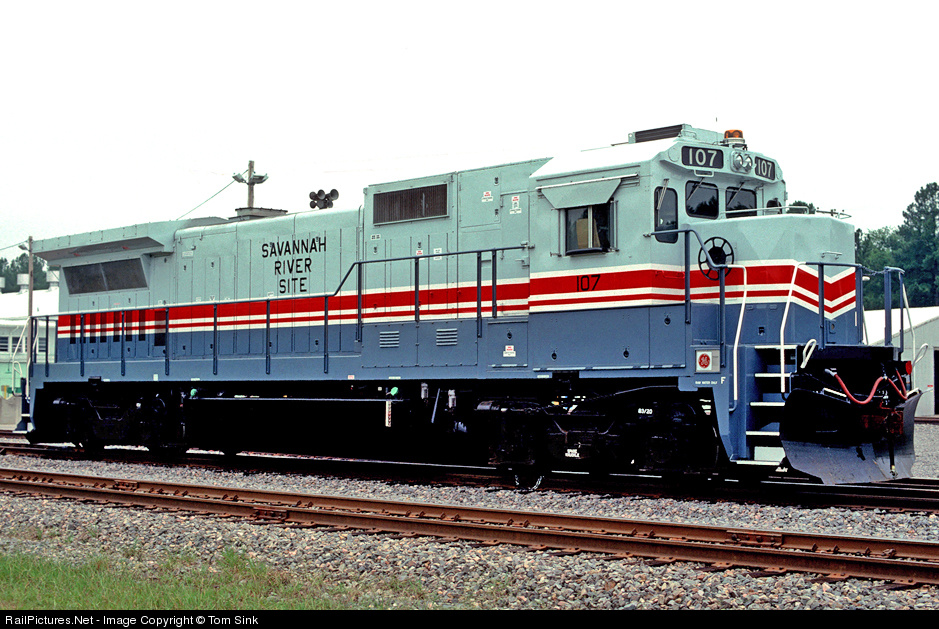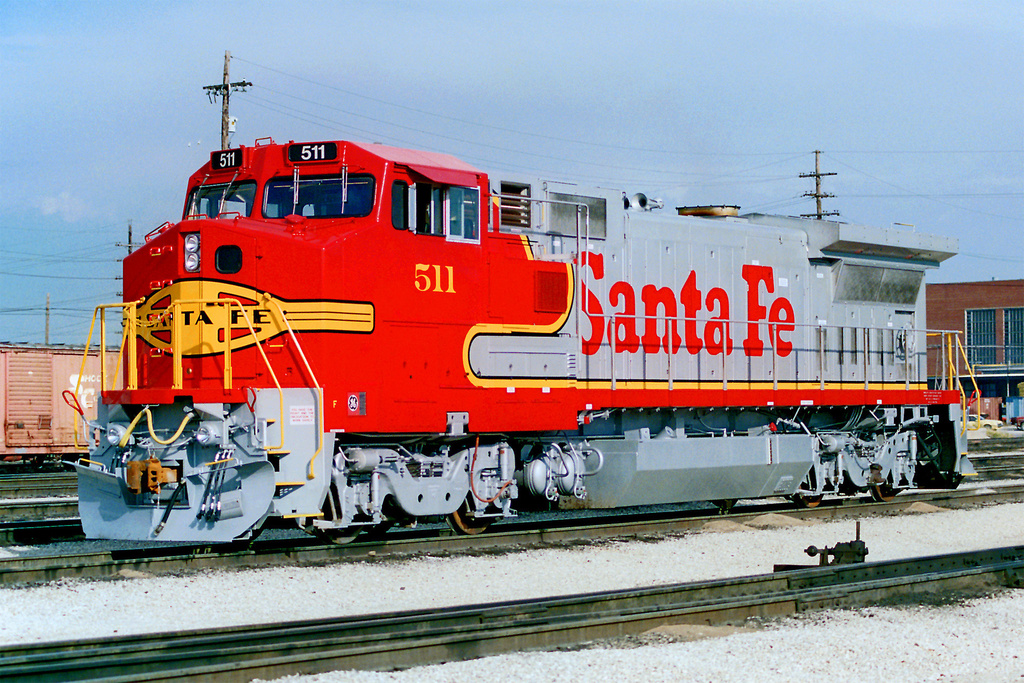B40 8 - MagnumMacKivler/RLCPT2 GitHub Wiki
 A GE B40-8 built for the Department of Energy's Savannah River nuclear site in South Carolina sits idle in Aiken, SC; likely on its way to be delivered shortly after it was built. This locomotive that comes from a single one ordered by DOE, is rarely photographed because of the security involved to even get close to it. Photo credit Tom Sink.
A GE B40-8 built for the Department of Energy's Savannah River nuclear site in South Carolina sits idle in Aiken, SC; likely on its way to be delivered shortly after it was built. This locomotive that comes from a single one ordered by DOE, is rarely photographed because of the security involved to even get close to it. Photo credit Tom Sink.
The GE B40-8 is a 4 axle, B-B configuration locomotive that has 4000 horsepower, and is included in GE's Dash 8 lineup. This locomotive supersedes the B32-8, and was offered alongside the B39-8 / B39-8E. This locomotive is also related to the 6 axle C40-8
Initially offered in 1988, this locomotive, much like competitor EMD's GP60, is a high horsepower 4 axle engine designed to move fast freights and intermodals / trailer trains at speeds of 70 mph or greater to keep up with high priority container and trailer traffic that began to see a rise around the late 1970s.
Orders came from various different railroads; Conrail started out the orders in April of 1988, and ordered 30 of them. Subsequent orders came from Santa Fe (40; not to be confused with the B40-8W mentioned later), New York Susquehanna and Western (24), St Louis Southwestern/Cotton Belt (55), and a notable single locomotive that was tacked on to the last SSW order for the United States Department Of Energy's Savannah River Site. Built to SSW spec, this locomotive, along with a single GP60 also ordered, works transporting equipment to the nuclear facility from interchange, and is rarely seen outside of the plant because of the security involved with it. In total, 150 were made for railroads, and 1 was made for General Electricas likely a demo/warranty/testbed unit.
In 1988, General Electric then started testing on a widecab design on their B40-8s and C40-8s. Eventually, they then offered production of the B40-8W, with the "W" standing for Widecab. the B40-8W only had one customer; the ATSF/Santa Fe railroad. ATSF, ordering also a wide cab variant of the GP60 named the GP60M, also ordered the B40-8W for high speed intermodal service across their relatively flat intermodal trains from California to the midwest. This almost also lead to a B40-8 B-unit, much like the GP60B, but the price was found to be the same as a widecab unit. In total, ATSF ordered 83, with once again GE having a singular one also made as a testbed at their Erie plant.

ATSF 511 in fresh Warbonnet paint (a paint scheme revived by the company for their wide cab units in the late 80 and early 90s), sits in ATSF's Argentine Yard in Kansas Cit, Missouri shortly after delivery on October 20th of 1990. Photo credit trainspo.com use Maersk.146
Eventually, as the railroads moved into the 1990s and the 2000s, 6 axle units, especially ones with AC motors, started to take over the intermodal game, as well as regular freight trains and other road trains. The B40-8s and B40-8Ws, along with all other high horsepower 4 axle power, found themselves designated to switcher and local service around the turn of the millennium, occasionally helping out with road freights from time to time if they were ready to go.
Towards the mid to late 2010s, the Dash 8 line of locomotives in general soon started to see mass retirements around all of the Class 1 systems, with several being sold into second hand use (a rather funny case is CSX selling B40-8s and C40-8s to Pan Am Railways; Pan Am was then bought by CSX, and thus these along with several C40-8s were returned to CSX service for extended use). Additionally, others were scrapped or sold to locomotive brokers like LTEX. One noteable exception to this was BNSF, who is still running some B40-8Ws in local service in August of 2024 around various parts of the system long after retiring their C40-8Ws and B40-8s.
Two locomotives have since been preserved: Union Pacific B40-8s 1848 (originally built in 1988 as Cotton Belt 8049) was donated to the Illinois Railway Museum in running condition in 2014. IRM has kept this locomotive in UP paint for now. Another is BNSF B40-8W 537 (Originally ATSF 537 blt. OCt 1990) that was donated to Railroading Heritage of Midwest America (Knownn for having the UP challenger, UP DDA40X 6936, among other things in the former National Railway Equipment's/Rock Island Railroad's Silvis, IL shops.). BNSF 537, as of writing this page in August 2024, is undergoing a repaint in the shops to be restored back to its original Warbonnet colors.
PT-Specific Information
| General Info | - |
|---|---|
| Prime Mover | GE-7FDL16K (1) |
| Horsepower | 4000 for traction |
| Truck Type | GE FB-2 |
| Axles | 4 |
| Traction Motors | 4 |
| Minimum Weight | 287,000 lbs (B40-8)/290,000 lbs (B40-8W)⚠ |
| Maximum Weight | 291,000 lbs ⚠ |
| Model Base Speed | 70 MPH |
| Top Speed | 70, 75, 80 or 86 ⚠ (2) |
| Electrical System | - |
|---|---|
| Generator Max Current | 10200 Amps |
| Max Traction Motor (TM) Current | 1800 Amps |
| Max Continuous TM Current | 1360 Amps |
| Traction Motor Type | DC |
| Factor of Adhesion | 29% ⚠ |
| Transition Mode | Automatic, no selector |
| Transition Groups | 1 |
| Transition Shunts | 1 |
| Generator Transition | Yes |
| Traction Control | APR + Sand** |
| Dynamic Braking (DB) Mode (if used) | Electrical Blowers (3) |
| DB Max Current | 900 Amps (4) |
| DB Max Continuous Current | 900 Amps |
| Blended Braking | No |
| Miscellaneous | - |
|---|---|
| Head-End Power (HEP) | No |
| HEP Power Consumption | N/A |
| HEP Standby/Run Mode | N/A |
| Load Ramp Speed | 3 Amps/Tick ⚠ |
| TM Overload Protection | Yes |
| Starter Mode | Manual Primer, Manual Start |
| Air Brake Schedule | 26-L |
| Compressor CFM | 236.25 (Wabco 3CDCBL @ 1050 RPM) |
| Main Reservoir Volume | 32.4 Cu.Ft |
Notes
⚠: Not Verified or Educated Guess
(1) Later units were sold with the 7FDL16L and Y.
(2) Only 70MPH gearing was available for B40-8s from what can be found.
(3) Engine RPM directly varies with brake handle position so.. probably having Mech Blowers, and the notch at 0 would be more accurate. The sounds are part of the engine config anyway.
(4) The default braking grid system, called "Flat" or "Field Current Control", limited both the motor field current and the braking grid amperage, so that no overload was possible at any speed and the braking system behaved so that braking effort was a proportion of the braking handle even at high speed; the nuances are a bit tricky to describe. The optional system, "Tapered" or "Grid Current Control", provides a fixed grid current limit where the motor field current is exclusively a function of the braking handle position; this is more analagous to how legacy systems worked. Minimum level excitation would still max out the braking effort at high speed. If you wish to cosplay as using the optional system, Max Braking Amps is 1200. No other difference is presently modeled in PT2.